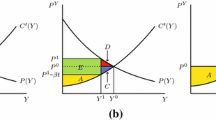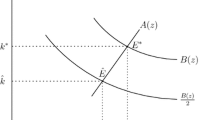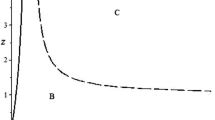Abstract
The paper considers relative standards which limit the level of emissions per unit of output. The representative firm is characterized by a cost function describing the actual production process, a separate abatement technology, and the fact that (gross) emissions are proportional to output. At first, the implications of a relative standard and of its marginal change for a single firm are examined. It is shown that the standard cannot be replaced by a corresponding tax. Afterwards a positive analysis is performed for an industry consisting of identical firms under perfect competition. Comparative statics are used to analyze the impacts of changes in the relative standard in a short-run and long-run equilibrium. It turns out that the standard always possesses a price effect. Moreover the relevant factors which govern price, quantity, and profit changes are revealed. Then the paper characterizes the optimal standard for the same framework. A main result is that the first-best allocation can never be obtained by means of a relative standard, even if firms are identical. The influence of the demand and supply side on an optimal standard can be demonstrated since the underlying model is simple and transparent. The resulting market price is compared to social marginal costs. Finally the investigation is extended to monopoly and symmetric oligopoly.
Similar content being viewed by others
References
Barnett, A. H. (1980): “The Pigouvian Tax Rule under Monopoly.”American Economic Review 70: 1037–1041.
Besanko, D. (1987): “Performance versus Design Standards in the Regulation of Pollution.”Journal of Public Economics 34: 19–44.
Buchanan, J. M., and Tullock, G. (1975): “Polluters' Profits and Political Response: Direct Controls versus Taxes.”American Economic Review 65: 139–147.
Cullis, J., and Jones, P. (1992):Public Finance and Public Choice. London: McGraw Hill.
Ebert, U. (1991): “Pigouvian Tax and Market Structure.”Finanzarchiv 49: 154–166.
— (1996): “Naive Use of Environmental Policy Instruments and Market Structure.” InEnvironmental Policy and Market Structure, edited by C. Carraro, Y. Katsoulacos, and A. Xepapadeas. Dordrecht: Kluwer.
Farzin, Y. H. (1996): “Can Higher Environmental Standards Enhance Competititon and Welfare?” Working Paper 87.96, Fondazione Eni Enrico Mattei, Milano.
Harford, J. D. (1984): “Relatively Efficient Pollution Standards under Perfect Competition.”Public Finance Quarterly 12: 183–195.
Harford, J. D., and Karp, G. (1983): “The Effects and Efficiencies of Different Pollution Standards.”Eastern Economic Journal 9: 79–89.
Harford, J., and Ogura, S. (1983): “Pollution Taxes and Standards: a Continuum of Quasi-optimal Solutions.”Journal of Environmental Economics and Management 10: 1–17.
Helfand, G. E. (1991): “Standards versus Standards: the Effects of Different Pollution Restrictions.”American Economic Review 81: 622–634.
Mäler, K.-G. (1974):Environmental Economics: a Theoretical Inquiry. Baltimore: The Johns Hopkins University Press.
Novshek, W. (1985): “On the Existence of Cournot Equilibrium.”Review of Economic Studies 52: 85–98.
Russell, C. S., Harrington, W., and Vaughan, W. J. (1986):Enforcing Pollution Control Laws. Washington, DC: Resources for the Future.
Seade, J. (1980): “The Stability of Cournot Revisited.”Journal of Economic Theory 23: 15–27.
Spulber, D. F. (1985): “Effluent Regulation and Long-run Optimality.”Journal of Environmental Economics and Management 12: 103–116.
Weitzman, M. (1974): “Prices vs. Quantities.”Review of Economic Studies 41: 477–491.
Author information
Authors and Affiliations
Rights and permissions
About this article
Cite this article
Ebert, U. Relative standards: A positive and normative analysis. Zeitschr. f. Nationalökonomie 67, 17–38 (1998). https://doi.org/10.1007/BF01227761
Received:
Revised:
Issue Date:
DOI: https://doi.org/10.1007/BF01227761




